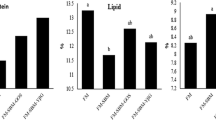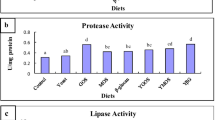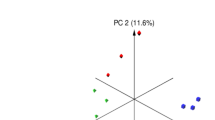Abstract
Two separate experiments were conducted with hybrid striped bass to evaluate four potential prebiotics: GroBiotic®-A (partially autolyzed brewer’s yeast, dairy ingredient components, and fermentation products), mannanoligosaccharide (MOS), galactooligosaccharide (GOS), and inulin. In the in vitro experiment, intestinal contents were incubated with the individual prebiotics (0.5% by weight) at 25°C for 24 and 48 h. Analysis of volatile fatty acids in the supernatant showed that GroBiotic®-A, MOS, and GOS tended to produce lower acetate levels but higher butyrate levels at 48 h compared to diet alone. However, denaturing gradient gel electrophoresis (DGGE) analysis failed to detect any differences in the composition of the microbial community among treatments. DNA sequencing of a common band for all inoculated samples revealed close similarity to the anaerobic Fusobacteria bacterium. An 8-week feeding trial also was conducted to evaluate the four prebiotics looking at growth performance; weight gain, feed efficiency ratio, protein efficiency ratio, whole-body ash, moisture, and lipid did not vary among fish fed the various diets. However, DGGE analysis revealed that all prebiotics produced a different type of microbial community in the intestinal tract of hybrid striped bass compared to fish fed the basal diet. Thus, GroBiotic®-A, FOS, GOS, and MOS exhibited prebiotic effects in hybrid striped bass.


Similar content being viewed by others
References
Bailey J, Blankenship L, Cox N (1991) Effect of fructooligosaccharide on Salmonella colonization of the chicken intestine. Poult Sci 70:2433
Bakke-McKellep AM, Penn MH, Salas PM, Refstie S, Sperstad S, Landsverk T, Krogdahl Å (2007) Effects of dietary soybean meal, inulin and oxytetracycline on intestinal microbiota and epithelial cell stress, apoptosis and proliferation in the teleost Atlantic Salmon (Salmo salar L.). Br J Nutr 97:699
Bongers A, van den Heuvel EGHM (2003) Prebiotics and the bioavailability of minerals and trace elements. Food Rev Int 19:397
Burr G, Ricke S, Gatlin DM III (2005) Microbial ecology of the gastrointestinal tract of fish and the potential application of prebiotics and probiotics in fishfish aquaculture. J World Aquacult Soc 36:425
Burr GS, Li P, Goff JB, Grisdale-Helland B, Hellend SJ, Gatlin DM III (2006) Evaluation of growth performance and whole-body composition of juvenile hybrid striped bass Morone chrysops x Morone saxatilis and red drum Sciaenops ocellatus fed high-protein and high-lipid diets. J World Aquacult Soc 37:421
Burr G, Hume M, Gatlin DM III (2007) Effects of prebiotics on nutrient digestibility of a soybean meal-based diet by red drum Sciaenops ocellatus (Linnaeus). Aquac Res 39:1680
De De Hertogh G, Aerssens J, De Hoogt R, Peeters P, Verhasselt P, Van Eyken P, Ectors N, Vermeire S, Rutgeerts P, Coulie B, Geboes K (2006) Validation of 16S rDNA sequencing in microdissected bowel biopsies from Crohn’s disease patients to assess bacterial flora diversity. J Pathol 209:532
Fioramonti J, Theodorou V, Bueno L (2003) Probiotics: what are they? What are their effects on gut physiology? Best Pract Res Clin Gastroenterol 17:711
Flickinger EA, Van Loo J, Fahey GC Jr (2003) Nutritional responses to the presence of inulin and oligofructose in the diets of domesticated animals: a review. Crit Rev Food Sci Nutr 43:19
Heikkinen J, Vielma J, Kemiläinen O, Tiirola M, Eskelinen P, Kiuru T, Navia Paldanius E, von Wright A (2006) Effects of soybean meal based diet on growth performance, gut histopathology and intestinal microbiotia of juvenile rainbow trout (Oncorhynchus mykiss). Aquaculture 261:259
Hinton A Jr, Corrier DE, Spates GE, Norman JO, Ziprin RL, Beier RC, Deloach Jr (1990) Biological control of Salmonella typhimurium in young chickens. Avian Dis 34:626
Holt JG, Krieg NR, Sneath PHA, Staley JT, Williams ST (eds) (1994) Bergey’s manual of determinative bacteriology. Group 6, Gram-negative, anaerobic, straight, curved, and helical bacteria, vol 9. Williams & Wilkins, Baltimore, p 291
Hughes SA, Shewry PR, Li L, Gibson GR, Sanz ML, Rastall RA (2007) In vitro fermentation by human fecal microflora of wheat arabinoxylans. J Agric Food Chem 55:4589
Hume ME, Kubena LF, Edrington TS, Donskey CJ, Moore RW, Ricke SC, Nisbet DJ (2003) Poultry digestive microflora biodiversity as indicated by denaturing gradient gel electrophoresis. Poult Sci 82:1100
Johnson EA (1990) Foodborne Diseases. Clostridium perfringens food poisoning. Academic, California, p 229
Kandel JS, Horn MH, Van Antwerp W (1994) Volatile fatty acids in the hindguts of herbivorous fishes from temperate and tropical marine waters. J Fish Biol 45:527
Kihara M, Ohba K, Sakata T (1995) Trophic effect of dietary lactosucrose on intestinal tunica muscularis and utilization of this sugar by gut microbes in red seabream Pagrus major, a marine carnivorous teleost, under artificial rearing. Comp Biochem Physiol 112:629
Kihara M, Sakata T (1997) Fermentation of dietary carbohydrates to short chain fatty acids by gut microbes and its influence on intestinal morphology of a detritivorous teleost tilapia (Oreochromis nilocitus). Comp Biochem Physiol 118:201
Kihara M, Sakata T (2001) Influences of incubation temperature and various saccharides on the production of organic acids and gases by but microbes of rainbow trout Oncorhynchus mykiss in a micro-scale batch culture. J Comp Physiol B 171:441
Kihara M, Sakata T (2002) Production of short-chain fatty acids and gas from various oligosaccharides by gut microbes of carp (Cyprinus carpio L.) in micro-scale batch culture. Comp Biochem Physiol 132:33
Li P, Gatlin DM III (2004) Dietary brewer’s yeast and the prebiotic Grobiotic™-AE influence growth performance, immune response and resistance of hybrid stripped bass (Morone chrysops X M. saxatilis) to Streptococcus iniae infection. Aquaculture 231:445
Li P, Gatlin DM III (2005) Evaluation of the prebiotic GroBiotic®-A and brewers yeast as dietary supplements for sub-adult hybrid striped bass (Morone chrysops × M. saxatilis) challenged in situ with Mycobacterium marinum. Aquaculture 248:197
Mahious AS, Gatesoupe FJ, Hervi M, Metailler R, Ollevier F (2006) Effect of dietary inulin and oligosaccharides as prebiotics for weaning turbot, Psetta maxima (Linnaeus, C. 1758). Aquac Int 14:219
Manning T, Gibson G (2004) Prebiotics. Best Pract Res Clin Gastroenterol 18:287
Moon HY, Gatlin DM III (1991) Total sulfur amino acid requirement of juvenile red drum, Sciaenops ocellatus. Aquaculture 95:97
Mounfort DO, Campbell J, Clements KD (2002) Hindgut fermentation in three species of marine herbivorous fish. Appl Environ Microbiol 68:1374–1380
Muyzer G, de Waal EC, Uitterlinden AG (1993) Profiling of complex microbial populations by denaturing gradient gel electrophoresis analysis of polymerase chain reaction-amplified genes encoding for 16S rDNA. Appl Environ Microbiol 59:695
Patterson J, Burkholder K (2003) Application of prebiotics and probiotics in poultry production. Poult Sci 82:627
Plante S, Pernet F, Haché R, Ritchie R, Ji B, McIntosh D (2007) Ontogenetic variations in lipid class and fatty acid composition of haddock larvae Melanogrammus aeglefinus in relation to changes in diet and microbial environment. Aquaculture 263:107
Pond MJ, Stone DM, Alderman DJ (2006) Comparison of conventional and molecular techniques to investigate the intestinal microflora of rainbow trout (Oncorhynchus mykiss). Aquaculture 261:194
Raqib R, Sarker P, Bergman P, Ara G, Lindh M, Sack DA, Masirul Islam KM, Gudmundsson GH, Anderson J, Agerberth G (2006) Improved outcome in shigellosis associated with butyrate induction of an endogenous peptide antibiotic. Proc Natl Acad Sci USA 103:9178
Ringø E, Sperstad S, Myklebust R, Refstie S, Krodghal Å (2006a) Characterization of the microbiota associated with the intestine of Atlantic cod (Gadus morhuaL.) The effect of fish meal, standard soybenm meal and bioprocessed soybean meal. Aquaculture 261:829
Ringø E, Sperstad S, Myklebust R, Mayhew T, Olsen R (2006b) The effect of dietary inulin on aerobic bacteria associated with hindgut of Artic charr (Salvelinus alpinus L.). Aquacult Res 37:891
Romero J, Navarrete P (2006) 16S rDNA-based analysis of dominant bacterial populations associated with early life stages of Coho salmon (Onchrohynchus kisutch). Microb Ecol 51:422–430
SAS Institute Inc (1985) SAS User’s guide statistics, Version 5.2 ed. SAS Institute Inc, Cary, p 956
Shermer C, Maciorowski KG, Bailey CA, Byers FM, Ricke SC (1998) Ceacal metabolites and microbial populations in chickens consuming diets containing a mines humate compound. J Sci Food Agric 77:479
Smiricky-Tjardes M, Grieshop C, Flickinger E, Bauer L, Fahey G Jr (2003) Dietary galactooligosaccharides affect ileal and total-tract nutrient digestibility, ileal and fecal bacterial concentrations, and ileal fermentative characteristics of growing pigs. J Anim Sci 81:2535
Smith TB, Wahl DH, Mackie RI (1996) Volatile fatty acids and anaerobic fermentation in temperate piscivorous and omnivorous freshwater fish. J Fish Biol 48:829
Spears JK, Karr-Lilienthal LK, Bauer LL, Murphy MR, Fahey GC Jr (2007) In vitro fermentation characteristics of selected glucose-based plymers by canine and human fecal bacteria. Arch Anim Nutr 61:61
Van Immerseel F, Russell JB, Flythe MD, Gantois I, Timbermont L, Pasmans F, Haesebrouck F, Ducatelle R (2006) The use of organic acids to combat Salmonella in poultry: a mechanistic explanation of the efficacy. Avian Pathol 35:182
Ward DM, Weller R, Bateson MM (1990) 16S rRNA sequences reveal numerous uncultured microorganisms in a natural community. Nature 345:63
Webb KA Jr, Gatlin DM III (2003) Effects of dietary protein level and form on production characteristics and ammonia excretion of red drum Sciaenops ocellatus. Aquaculture 225:17
Acknowledgments
The authors would like to thank Texas Sea Grant College Program for funding this research. We also would like to thank International Ingredient Corporation (St. Louis, MO, USA) for providing the GroBiotic®-A, Alltech Biotechnology for the Bio-MOS®, Friesland Foods, Inc. for the Vivinal GOS, and Encore Technologies for the inulin. Keo Fish Farms generously provided the hybrid striped bass used in this study.
Author information
Authors and Affiliations
Corresponding author
Rights and permissions
About this article
Cite this article
Burr, G., Hume, M., Ricke, S. et al. In Vitro and In Vivo Evaluation of the Prebiotics GroBiotic®-A, Inulin, Mannanoligosaccharide, and Galactooligosaccharide on the Digestive Microbiota and Performance of Hybrid Striped Bass (Morone chrysops × Morone saxatilis). Microb Ecol 59, 187–198 (2010). https://doi.org/10.1007/s00248-009-9597-6
Received:
Accepted:
Published:
Issue Date:
DOI: https://doi.org/10.1007/s00248-009-9597-6




